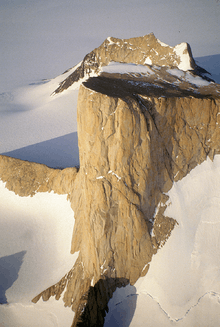The Billboard

The Billboard (77°4′S 145°40′W / 77.067°S 145.667°WCoordinates: 77°4′S 145°40′W / 77.067°S 145.667°W) is a massive granite monolith in the Sarnoff Mountains of the Ford Ranges of Marie Byrd Land, West Antarctica, standing just west of Mount Rea between Arthur Glacier and Boyd Glacier. It was discovered in November 1934 by a Second Byrd Antarctic Expedition (1933–35) sledge party under Paul Siple, and is so named because of its form and appearance with vertical faces rising above the continental ice.
The summit was first visited by helicopter in January 1993 during expedition GANOVEX VII. In 1998-99 a geological party from Colorado College reached the summit by climbing a west route.[1]
Geology
It is topped by an erosion surface that reaches an elevation of 793 metres (2,602 ft), which is about 700 m above the outlet glacier below. The surface lacks glacial erosion features such as striae and whaleback forms; however erratics found on the surface provide evidence of overriding by cold-based glacier ice. Features characteristic of prolonged surface weathering in a sub aerial environment are sheeting and weathering pits.[2][3]
References
- ↑ Bruce Luyendyk, personal communication, 2010
- ↑ Stone, J.O., Balco, G.A., Sugden, D.E., Caffee, M.W., Sass III, L.C., Cowdery, S.G., and Siddoway, C., 2003, Holocene Deglaciation of Marie Byrd Land, West Antarctica: Science, v. 299, p. 99-102
- ↑ Sugden, D.E., Balco, G., Cowdery, S.G., Stone, J.O., and III, L.C.S., 2005, Selective glacial erosion and weathering zones in the coastal mountains of Marie Byrd Land, Antarctica: Geomorphology, v. 67, p. 317-334
![]() This article incorporates public domain material from the United States Geological Survey document "The Billboard" (content from the Geographic Names Information System).
This article incorporates public domain material from the United States Geological Survey document "The Billboard" (content from the Geographic Names Information System).